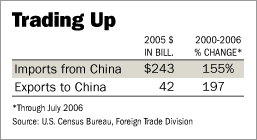 From today's WSJ editorial page, an excellent article about US trade with China:
From today's WSJ editorial page, an excellent article about US trade with China:This explosion of cross-border commerce has worked to the benefit of both nations. China has had a compounded rate of GDP growth of 10% for the past five years. A report by McKinsey consulting finds that if anywhere near these rates of GDP growth are sustained over the next decade, poverty rates in China -- a nation barely able to maintain subsistence living standards for centuries -- will fall by two-thirds.
What has America gained? A surge in low-priced, high quality consumer products. Apparel, footwear, consumer electronics, computer equipment, and so on -- all of which Americans have bought voluntarily (MP: countries don't trade, individual companies and individual consumers trade). Arguably the biggest beneficiary of China's emergence on the world trading stage has been America's poor, who have new access to bargain-priced consumer goods. A 27.5% China tariff would be the most regressive tax imposed on low income Americans in decades.
The standard response from the China-bashers (just as the Japan-bashers argued two decades ago) is that America is "exporting" jobs overseas. But over the time period that trade with China has surged, so has the number of new jobs created here. Yes, some U.S. manufacturers have lost market share to lower-cost Chinese competitors, and in recent years U.S. apparel and light manufacturing firms have brought a series of anti-dumping complaints against the Chinese.
But it's a myth that U.S. manufacturing is disappearing. A recent Cato Institute report shows that U.S. manufacturing output is up 50% in the past 12 years along with our expanding trade with China. And the National Association of Manufacturers reports that August was the tenth consecutive month in which U.S. manufactured goods exports rose more than imports. Outsourcing to China has allowed many U.S. companies to remain competitive against foreign producers, and a large chunk of U.S.-China trade is in fact intra-company trade conducted by American firms.
So has China "cheated" in the trade arena by holding the yuan artificially low relative to the dollar? The yuan has been pegged at 7.92 against the dollar since the mid-1990s, and Beijing has begun to allow a modest fluctuation in the last year or so. But this is not a "manipulation" of its exchange rate so much as it is a contracting out of its monetary system to the U.S. Federal Reserve Board. That strategy has allowed China to remove the uncertainty of exchange-rate fluctuations from investment decisions and allowed China to grow rapidly while controlling inflation (so long as the Fed controls it too, which is a separate issue).
The Chinese have thus avoided the bane of most developing nations of inept monetary controls leading to price fluctuations and periods of hyper-inflation. China was one of the few Asian nations that didn't face a crippling currency devaluation during the monetary crisis of the late 1990s.
Nor is it clear that a yuan revaluation of even 10% to 30% would have any meaningful impact on the U.S. trade deficit. China imports some $100 billion a year of raw materials. A stronger yuan would lower the price of those inputs, and thus of production costs, which could largely offset the impact of the stronger currency on export prices.





No comments:
Post a Comment